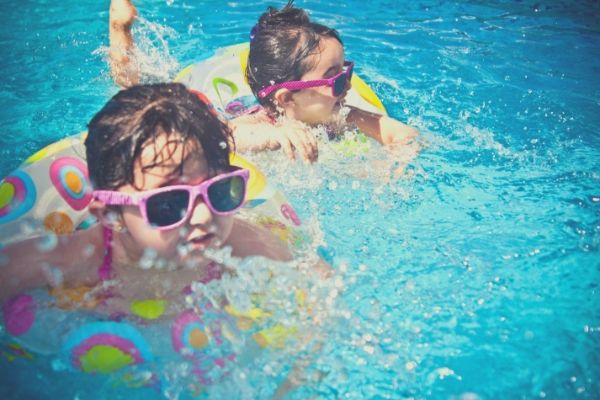Life vests and puddle jumpers are such an invaluable tool when it comes to learning to swim. They provide a gentle introduction to the water and give children confidence when they’re just learning about how to move their bodies in the water.
This is especially true for young children, who are still working out how to move their bodies on land! But life vests are a tool, and not a replacement for learning to swim independently. So how do you transition away from using a flotation aid in a way that is empowering rather than frightening? Here are some key pointers.
Remember that there’s more than one way to float.
Life vests are designed for one thing: to prevent drowning. And in general, they do a very good job of this! But what most are not designed for is to promote swimming. A traditional life vest will hold a child (or adult) relatively upright. The idea is to keep the head out of the water, which is perfect for someone who’s just fallen from a dock or out of a kayak. It’s not great for mobility, though. And puddle jumpers restrict arm mobility and development of skills that aid forward propulsion.
Working closely with your child using hand-held floats such as “noodles” or kickboards helps your child learn to float in new, more flexible ways. This is an opportunity for children to try letting their legs lift up behind them in a supported front float, or to lean backwards in the (initially scarier, but in many ways easier and more stable) back float.
Keep in touch. Truly.
Staying within arm’s reach of an active child may sound exhausting, but when transitioning towards increasingly independent swimming, it’s critical. Providing hands-on support can help alleviate that out-of-control feeling that invariably results when the comfortably constricting sensation of a life vest has been taken away.
Remember also that swimming can be exhausting, especially to new swimmers who haven’t yet developed any kind of efficient movement in the water. Young children who are having fun might not recognize the signs of tiredness or dehydration in themselves, and it’s not easy to see these kinds of subtle signs from the poolside, either. Staying physically close to your new swimmer and providing physical support as needed can mean the difference between a fun day of learning and a tragedy.
Not sure you know how to help? Work with an expert.
We all have different strengths. Some people tell stories in a way that leaves children absolutely entranced. Others have a knack for helping toddlers toilet train. Some people juggle the schedules of half a dozen children without breaking a sweat. If teaching children to swim isn’t your personal forte, why wait to get them started working with a teacher who lives for it?
Formal swim lessons are shown to reduce a child’s risk of drowning by 88%. Informal and inconsistent swim lessons have not.
At The Swim Revolution, we have a class designed especially for children who are new to swimming and are just learning to let go of the life vests and floaties in order to swim independently. Our Level 1 classes use specially-designed flotation devices that transition from extremely buoyant to no extra help at all. This, plus our tiny class sizes (two students to one instructor) and our professionally-designed curriculum helps children feel comfortable in the water while having fun, and gives them the skills they need to be safer swimmers for life.
Interested in learning more about our Level 1 swim classes?
Visit All About FUNdamentals for more information on this key stage of learning to swim. And if you have any questions, get in touch with us. We’re always happy to talk about how we can support you in making swimming a part of your child’s life.




